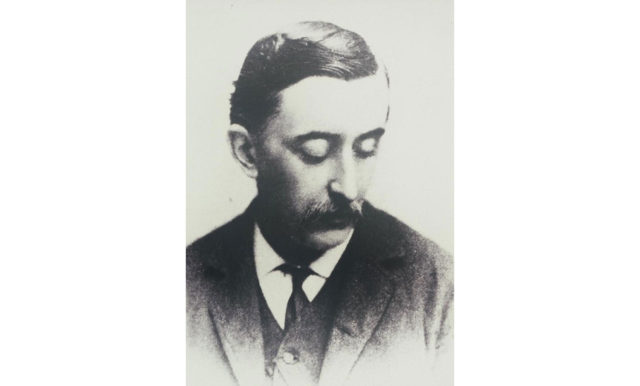By David Yamaguchi, The North American Post
JUNE 27TH is Lafcadio Hearn’s birthday. Known in Japan by his Japanese name, Koizumi Yakumo, he is arguably the most beloved and celebrated writer on Japan in the English language. Hearn arrived in Meiji-Era Japan in 1890, on a newspaper writing assignment, when it was still an unknown landscape to Americans.
Hearn is among my heroes. I remember a magical trip to Japan, in the 1990s, when I read his seminal “Glimpses of Unfamiliar Japan” while watching that very landscape zip by outside train windows.
Alert readers will recognize that I have copied three things from Hearn. The first two are stylistic.
First, Hearn incorporates Romanized native speech into English passages, to better describe the aural and cultural contexts of scenes, “kou yuu fuu ni” [like this].
From Hearn, I have also learned the usage of paired em dashes—for long subsidiary phrases within sentences—instead of using the more common form of phrases enclosed by paired commas.
At a third, deeper level, I am emulating Hearn’s describing the vanishing cultural landscapes he sees before his eyes. Here, of course, I am setting down the changing of Japanese American culture, as Nisei community elders give way to Sansei, and we, in turn, begin to step aside for Yonsei.
Yet, what readers familiar with Hearn’s writing on Japan don’t fully appreciate is how fine a writer he was before he set foot in Japan. For by then, he was nearly 40. He had been writing for publication for 18 years.
To see this, it is fitting that for Hearn’s birthday, we turn to his writing from New Orleans and from Martinique, in the West Indies. These were the last two of his New World wandering-reporter posts, which built on his earlier writing for the Cincinnati Daily Enquirer.
The passages below are from “The Selected Writings of Lafcadio Hearn,” a 566-page distillation of the best of the master wordsmith’s work. It is one of many Japan-related titles I received from a former Nisei neighbor, who sought to pass along her books.
From New Orleans, we learn:
“WHY CRABS ARE BOILED ALIVE. And for why you not have of crab? Because one must dem boil ‘live? It is all vat is of most beast to tell so. How you make for dem kill so you not dem boil? You not can cut dem de head off, for dat day have not of head. You not can break to dem de back, for dat dey not be only all back. You not can dem bleed until dey die, for dat dey not have blood. You not can stick to dem troo de brain, for dat dey be same like you—dey not have of brain.”
From Martinique, in turn, we observe the daily lives of “Les Blanchisseueses,” or washer women.
“ALWAYS BEFORE DAYBREAK they rise to work, while the vapors of the mornes fill the air with scent of mouldering vegetation—clayey odors—grassy smells; there is only a faint gray light, and the water of the river is very chill. One by one they arrive, barefooted, under their burdens built up tower-shape on their trays;—silently as ghosts they descend the steps to the river-bed, and begin to unfold and immerse their washing. They greet each other as they come, then become silent again; there is scarcely any talking; the hearts of all are heavy with the heaviness of the hour. But the gray light turns yellow; the sun climbs over the peaks; light changes the dark water to living crystal; and all begin to chatter a little. Then the city awakens; the currents of its daily life circulate again—thinly and slowly at first, then swiftly and strongly—up and down every yellow street… and over the bridges of the river. Passers-by pause to look down, and cry, ‘bonjou,’ che!’’ Idle men stare at some pretty washer, til she points at them and cries; ‘Gade missie-a ka guette nou!—anh! —anh!—anh!’ And all the others look up and repeat the groan—’anh!—anh!—anh!’ till the starers beat a retreat. The air grows warmer; the sky-blue takes fire; the great light makes joy for the washers; they shout to each other from distance to distance, jest, laugh, sing. Gusty of speech these women are; long habit of calling to one another through the roar of the torrent has given their voices a singular sonority and force; it is well worth while to hear them sing. One starts the song—the next joins her; then another and another, till all the channel rings from the melody from the bridge of the Jardin des Plantes to the Pont-bois;
“C’est moin qui te ka lave
Passe, raccommode…
[“It was I who washed and ironed and mended;—at nine o’clock at night thou didst put me out of doors, with my child in my arms—the rain was falling—with my poor straw mattress upon my head!… Doudoux! Thou dost abandon me… I have none to care for me.”]
It is only after writing eight books, and countless magazine and newspaper articles, does Hearn arrive in Japan, where he begins writing anew:
“’THE FIRST CHARM OF JAPAN is intangible and volatile as a perfume.
“It began for me with my first kuruma-ride out of the European quarter of Yokohama into the Japanese town…
“It is with the delicious surprise of the first journey through Japanese streets—unable to make one’s kuruma runner understand anything but gestures, frantic gestures to roll on anywhere, everywhere, since all is unspeakably pleasurable and new… There is some charm unutterable in the morning air, cool with the coolness of Japanese spring and wind-waves from the snowy cone of Fuji… The sun is only pleasantly warm; the jinrikisha, or kuruma, is the most cosy little vehicle imaginable; and the street-vistas, as seen above the dancing white mushroom-shaped hat of my sandaled runner, have an allurement of which I fancy that I could never weary….”
David Yamaguchi is a local Sansei. He has written for the Post since 2006. Tweet him @davidyamaguch10.








